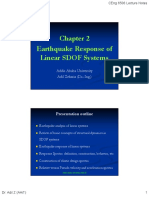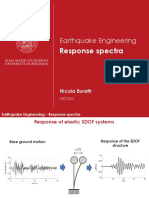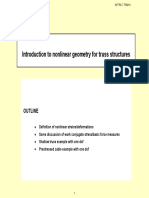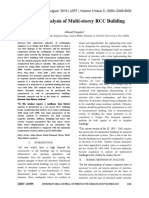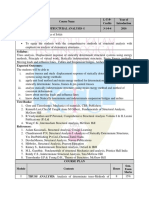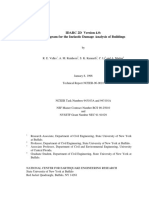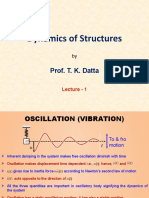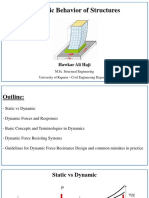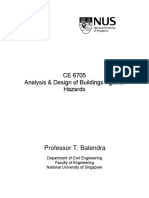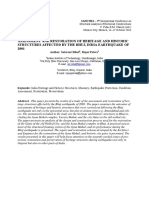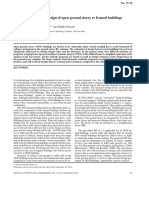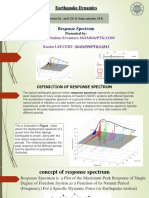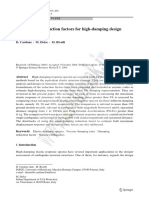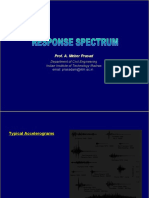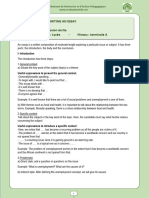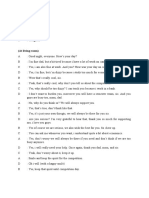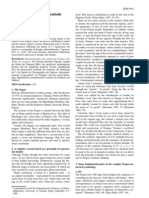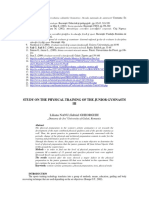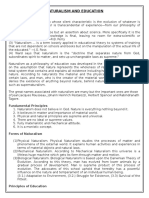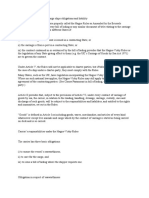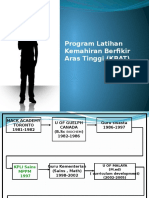Elastic Design Response Spectra
Uses
Envelop of a computed peak
dynamic response parameter for
Characterize ground motions and
assess demands on various types of
single degree of freedom elastic
simple structures.
systems having a range of
periods, for a given ground motion Basis for computing design
displacements and forces in SDOF
and viscous damping ratio
ma(t) + 2v(t) + Kd(t) = -mag (t)
SD= umax
=2%
=5%
=7%
and MDOF systems expected to
remain elastic.
Basis for developing design forces
and displacements in nonlinear
systems (two approaches):
Modified elastic spectrum to account for
nonlinearity
Equivalent elastic SDOF system
Period, sec.
CEE 227 - Earthquake Engineering
U.C. Berkeley
Spring 2009
UC Regents
7-1
�Design Response Spectrum
Statistical attenuation relationships
Simplified empirical relationships
(e.g., Newmark-Hall methods)
Uniform Hazard Spectrum
Period, sec.
2.5
Median
Median + 1
2
Acceleration,
SA
Spectral
Topics
Developing design spectra from site
specific ground motion time histories
Selection of damping values
Plotting formats
Analytic relations for developing
Elastic Design Response Spectrum
Deterministic
1.5
0.5
Sa
0
0
0.5
1.5
Period,
Basic approach (From USGS hazard
maps used in current codes)
Current spectra formulations found in
codes (how do they relate to theory?)
2.5
sec.
5% in 50 yrs.
Period
CEE 227 - Earthquake Engineering
U.C. Berkeley
Spring 2009
UC Regents
7-2
�Smooth Design Response Spectrum from
Ground Motion Records
Response Spectrum for actual
ground motions are quite irregular.
Dont use individual spectrum
for design
They can be used for analysis to
assess response to a particular
earthquake.
SA=2SD
Use suites of ground motions
representing:
A specific deterministic design
earthquake (e.g., M = 7 at 10 km)
Match a stipulated design response
spectrum (e.g., match code spectrum)
A range of earthquakes types
corresponding to the deaggregatized
seismic hazard at the site.
The design response spectrum is
obtained statically from all records.
The resulting median spectrum will be
relatively smooth. The COV or
Standard Deviation (lnx) can be used
to establish a design spectrum with a
desired probability of exceedence.
Note: Various programs do this
automatically.
median + 1
median
Period, sec.
CEE 227 - Earthquake Engineering
U.C. Berkeley
Spring 2009
UC Regents
7-3
�Generate Smooth Spectrum from Records
PEER NGA Database will
Bispec and other programs
search for particular types of
Permit user to input a suite of ground
records and plot scaled
motion records and will find median
response spectrum. Can
and median plus x values
download tables of spectral
values for different periods
and damping ratios
SA=2SD
median + 1
median
Period, sec.
CEE 227 - Earthquake Engineering
U.C. Berkeley
Spring 2009
UC Regents
7-4
�Viscous Damping
Viscous damping is a convenient
analytical concept to account for
general energy dissipation in a system
and analytical uncertainties.
Friction between and with structural
and non-structural elements.
Localized yielding due to stress
concentrations and residual stresses
under low loading and gross yielding
under higher loads.
Energy radiation through foundation.
Aeroelastic damping.
Viscous damping.
Analytical modeling errors.
Damping is generally a function of:
Material
Amplitude (stress)
Type of nonstructural elements
Type of foundations and supporting
soils
Frequency
Type of connections
Complexity of model (different parts of
structure will be responding differently)
Constant viscous damping is a
simplification.
Damping can produce substantial
forces that are only crudely modeled
compared to inertial and restoring
forces.
CEE 227 - Earthquake Engineering
U.C. Berkeley
Spring 2009
UC Regents
7-5
�Data on Viscous Damping
40
Viscous Damping Ratio, %
From: Hashimoto et al
Data for Welded Steel Moment
Frames, From Hashimoto et al, 1992
30
20
10
?
0
0.5
1.0
Stress Ratio, f/fy
1.5
References
NRC, "Regulatory Guide 1.61,
Damping Values for Seismic
Design of Nuclear Power Plants,"
U.S. Atomic Energy Commission.,
Oct. 1973.
Coats,D., "Damping in Building
structures During Earthquakes,
Test Data and Modeling,"
NUREG/CR-3006, Jan. 1989.
Hashimoto, P. et al, "Review of
Regulatory Guide 1.61 Structure
Damping Values for Elastic
Seismic Analysis of Nuclear
Power Plants," Nuclear Regulatory
Commission, 1992
CEE 227 - Earthquake Engineering
U.C. Berkeley
Spring 2009
UC Regents
7-6
�Recommended Design Damping Values
Many codes stipulate 5% viscous damping, unless a more properly
substantiated value can be used.
Note that actual damping values for many systems, even at higher
levels of excitation are less than 5%.
Structure Type
Welded Steel
Bolted Steel
Prestressed
Concrete
Reinforced
Concrete
Working Stress Range (no more
than about 1/2 yield stress)
NRC 1.61
Coats
2
4
2
2 to 3
5 to 7
2 to 3
3.5
4.5
TBD
2 to 5*
At or Just Below Yield Point
Hashimoto NRC 1.61
Coats
Hashimoto
4
7
5
5 to 7
10 to 15
5 to 7
4**
6
TBD
7 to 10
* lightly cracked sections represent lower values in range
** friction bolted connections same as welded steel
TBD: values to be determined when sufficient data is available
CEE 227 - Earthquake Engineering
U.C. Berkeley
Spring 2009
UC Regents
7-7
�Formats for Plotting Spectra
A variety of formats used
SA-T, SV-T, SD-T and SE-T
SV
Period, sec.
SA
Log SV
Log SA
0.03 0.13
SV = SD
Tripartite SA-SV-SD Format
LogSD
Recall: Only
SD vs T
plotted here
SA = SV = 2SD
SD= umax
Period, sec.
T=0.2 0.5
2.0
SA = 2 S D
SE =
Period, sec.
Log T
SA-SD Format
SA
SE
Building
Period, T
4.0 sec.
mSV2/2
6.0
Period, sec.
SD
CEE 227 - Earthquake Engineering
U.C. Berkeley
Spring 2009
UC Regents
7-8
�Basis of Tripartite Graph Paper
SV = SA / = SAT/2
= SD = 2SDT-1
Log SV
line of constant spectral acceleration
has a slope of 1 on a log-log plot of
SV vs. T
line of constant spectral displacement
has a slope of -1 on log-log plot of
SV vs. T
100 in/sec
Log SA
10g
1g
0.1g
0.01g
Log T
Log SV
Log SV
Line of Constant
Spectral Acceleration
100 in
10 in
10 in/sec
Line of Constant
Spectral
Displacement
1 in
Line of constant
Spectral Velocity
1 in/sec
Log SD
0.1 in
0.01 in
0.1 in/sec
Log T
0.01sec 0.1sec
1sec
Log T
10sec
CEE 227 - Earthquake Engineering
U.C. Berkeley
Spring 2009
UC Regents
7-9
�Tripartite Response Spectrum
After Fig. A6.1, Chopra,
Dynamics of Structures
CEE 227 - Earthquake Engineering
U.C. Berkeley
Spring 2009
UC Regents
7 - 10
�SA-SD Format
An alternative form of plotting
spectra has been introduced
recently and has started to appear
in building codes.
Intent is to plot information on
acceleration (force) and displacement on same graph with out
complexity of tripartite paper
Based on: SA = 2SD 2 = SA/ SD
Used to interpret nonlinear
response in conjunction with
Capacity Spectrum and Yield
Point Spectrum Methods -Discussed later
SA
Line of constant T2
SD
T=0.2
SA
0.5
2.0
Building
Period, T
4.0 sec.
6.0
SD
CEE 227 - Earthquake Engineering
U.C. Berkeley
Spring 2009
UC Regents
7 - 11
�Analytic Relations for Developing
Elastic Design Response Spectrum
Deterministic Approaches
Statistical attenuation relations for a given
magnitude, distance, soil condition, fault type, etc.
Simplified empirical methods by Newmark and
others for a given peak ground acceleration
Spectra based on Probabilistic Hazard Analysis
Uniform hazard methods (focus on USGS data)
NEHRP Tentative Provisions for Seismic
Regulations for New Buildings
CEE 227 - Earthquake Engineering
U.C. Berkeley
Spring 2009
UC Regents
7 - 12
�Statistically Derived Design Spectra
Bins of ground motions selected
with similar soil conditions, fault
mechanism, magnitude,
distance, etc.)
Response spectra generated
and averaged.
Regression analysis used to
develop equations for median
response spectrum and
standard deviation
Resulting equations can be
used in a seismic hazard
analysis to develop design
response spectrum with a
desired probability of
exceedence.
For given M, soil, mechanism, r
2.5
Median
Median + 1
Spectral
Acceleration,
1.5
0.5
0
0
0.5
1.5
Period,
2.5
sec.
CEE 227 - Earthquake Engineering
U.C. Berkeley
Spring 2009
UC Regents
7 - 13
�Many Investigators
Western US
References:
Interactive Tool on OpenSHA
Abrahamson &Silva
Boore, Joyner &Fumal
Campbell
Sadigh
Spudich
Central and Eastern US (CEUS)
Adkinson & Boore
Toro et al
Subduction Zones
Anderson
Atkinson & Boore
Youngs
Seismological Research Notes,
Vol. 68, No. 1, Jan.-Feb. 1997.
Joyner and Boore, Prediction of
Earthquake Response Spectra,
USGS Open File Report 82-977,
1982.
Crouse, Ground Motion
Attenuation Relationships for
Earthquakes in the Cascadia
Subduction Zone, Earthquake
Spectra, Vol. 7, No. 2, 1991.
CEE 227 - Earthquake Engineering
U.C. Berkeley
Spring 2009
UC Regents
7 - 14
�Typical Statistical Relations
Joyner and Boore (1982) -SV at 5%viscous damping.
Boore, Joyner and Fumal (1997) SV at 5% damping
log Sv (cm/sec) = + (M-6)
+ (-6) 2 - log r
log Sv (cm/sec) = b1 + b2 (M-6)
+ b3 (M-6) 2 + b4 r
+ b5 logr + b6 GB + b7 GC
+ b r +cS
Simple form, but imprecise
definition of soil conditions
and small number of ground
motions considered.
Period extend to 4 seconds.
Damping = 5% only
where r = [d 2 + h 2] 1/2 and terms
are defined on slide 6-14, and a
table of period specific coefficients
in cited reference.
Note:
Larger or random component
Periods 2 seconds
Damping = 5% only
CEE 227 - Earthquake Engineering
U.C. Berkeley
Spring 2009
UC Regents
7 - 15
�NGA Attenuation Relationships
Same process described in
slides 6-21 to 6-23 used for
estimating peak ground
acceleration at a site can be
used to generate a
smoothed response
spectrum for a particular site
(magnitude, fault type, soil
type, distance, etc.)
See class website for reports
and spreadsheets.
Campbell and
Bozorgnia, 2006
CEE 227 - Earthquake Engineering
U.C. Berkeley
Spring 2009
UC Regents
7 - 16
�Examples: Abrahamson & Silva
2.5
M=6.8, Soil, r = 3km
Median
Median + 1
1.5
1.8
M=6.8, r = 3km, Median
1.6
0.5
0
0
0.5
1.5
Period,
2
sec.
2.5
Acceleration,
1.4
Spectral
Spectral
Acceleration,
Soil
Rock
1.2
1
0.8
0.6
0.4
0.2
0
0
0.5
1.5
Period,
2.5
sec.
CEE 227 - Earthquake Engineering
U.C. Berkeley
Spring 2009
UC Regents
7 - 17
�Effect of Magnitude and Distance
1.4
r=1 km
M = 6.8
3 km
10 km
20 km
40 km
0.8
0.6
0.4
1.4
0
0.3
0.8
1.3
Period,
1.8
2.3
sec.
2.8
3.3
Acceleration,
0.2
-0.2
M = 7.8
M = 6.8
M = 5.8
1.2
Spectral
Spectral
Acceleration,
1.2
Abrahamson & Silva, Soil,
median values
0.8
0.6
0.4
0.2
r = 3 km
0
0
0.5
1.5
Period,
2.5
sec.
CEE 227 - Earthquake Engineering
U.C. Berkeley
Spring 2009
UC Regents
7 - 18
�Compare Various Attenuation Relations
M = 6.8, Strike-slip faulting, soil, r = 3 km, median values
1.4
Sadigh
Abrahamson and Silva
Campbell
Spectral
Acceleration,
1.2
Spudich
Joyner & Boore
0.8
0.6
0.4
0.2
0
0
0.5
1.5 sec.
Period,
2.5
CEE 227 - Earthquake Engineering
U.C. Berkeley
Spring 2009
UC Regents
7 - 19
�Directivity Effects
The fault normal component of motion
generally is substantially worse than
the fault parallel component. This is
primarily true for T >1 sec.
This depends on the direction of fault
rupture relative to the site. If the fault
ruptures toward a building site, the
effect is worse.
See:
Section 5.4.5.3 in Ch. 5 Bozorgnia
and Bertero Text;
Somerville papers on Class
Reference List
May result in need for increased design
forces / displacements for long period
structures close to faults (in one direction)
Hypocenter
Site
Propagation
SANormal/SAave
2
1
0
45
90
SA
T, sec.
Fault Normal
Median
Fault Parallel
CEE 227 - Earthquake Engineering
U.C. Berkeley
Spring 2009
UC Regents
7 - 20
�Directivity Effects (continued)
The fault normal motion is increased and
fault parallel motion is decreased
compared to the average spectrum from
an attenuation relation.
Broadband scaling
Somerville, P. et al, Modification of empirical
ground motion attenuation relations to include the
amplitude and duration effects of rupture
directivity, Seismological Research Notes, 68,
199-222.
Narrow Band Scaling
Somerville, P., Magnitude scaling of the near fault
rupture directivity pulse, Proceedings, Int.
Workshop on Quantitative Prediction of Strong
Motion ad the Physics of Earthquake Sources,
Oct. 2001, Tsukuba, Japan
NGA
Spudich, P. and Choi, B., Directivity in Preliminary
NGA Residuals, Report on Lifelines Program Task
1M01, PEER, Nov. 2006.
CEE 227 - Earthquake Engineering
U.C. Berkeley
Spring 2009
UC Regents
7 - 21
�Simplified Empirical Relations to
Construct Elastic Design Spectrum
The complexity of the previous Basic Concept
methods, and the limited
SAmax
number of records available
a= SAmax/PGA
two decades ago, led many
PGA
investigators to develop
simplified empirical methods for
Period
developing design spectrum
SVmax
from estimates of peak or
effective ground motion
v= SVmax/vgmax
parameters.
Based on the concept that all
Period
spectra have a characteristic
SDmax
shape
dg
Many artifacts of this can be
max d= SDmax/dgmax
seen in current code spectra
Period
CEE 227 - Earthquake Engineering
U.C. Berkeley
Spring 2009
UC Regents
7 - 22
�Newmark and Hall Approach
Need to know ag
max
dg
plus a, v and d
Get ag
max
max,
, vg
max
and
Structural Response
Amplification factors
from deterministic or
probabilistic site hazard analysis
Get vg
max
and dg
max,
from:
site hazard analysis
empirical functions using ag
max
Estimating dg
is problematic,
max
but not generally important unless
T is > 4 sec.
Damping
%
1
2
5
10
20
Median Structural
Response
Amplification
Factors
!d
!v
!a
1.82
1.63
1.39
1.2
1.01
2.31
2.03
1.65
1.37
1.08
3.21
2.74
2.12
1.64
1.17
See: Newmark and Hall, Earthquake Spectra
and Design, EERI Monograph, EERI,
Oakland, 1982
CEE 227 - Earthquake Engineering
U.C. Berkeley
Spring 2009
UC Regents
7 - 23
�Newmark and Hall Elastic Spectra
Damping
1
2
5
10
20
Median Structural
Response
Amplification
Factors
Median plus one !
Response
Aplification
Factors
"d
"v
"a
"d
"v
"a
1.82
1.63
1.39
1.20
1.01
2.31
2.03
1.65
1.37
1.08
3.21
2.74
2.12
1.64
1.17
2.73
2.42
2.01
1.69
1.38
3.38
2.92
2.30
1.84
1.37
4.38
3.66
2.71
1.99
1.26
See: Newmark and Hall, Earthquake Spectra and Design, EERI
Monograph, EERI, Oakland, 1982
CEE 227 - Earthquake Engineering
U.C. Berkeley
Spring 2009
UC Regents
7 - 24
�Construction of N-H Spectrum
Short period range(less than
0.03 sec): SA=ag
max
Amplified acceleration range
( T equal and somewhat
greater than 0.16 sec):
Constant SA = aag
max
Intermediate Period Range Constant SV = vvg
max
Long Period Range Constant SD = ddg
Note:
SV = SA / [SA=2Sv/T]
(constant SV proportional
to 1/T on conventional SA
versus T plot)
SD = SA / 2 [SD=4 2SA/T2]
(constant SD proportional
to 1/T 2 on conventional SA
versus T plot)
SA
max
Very long period Range Constant SD = dg
SA=PGA
max
CEE 227 - Earthquake Engineering
U.C. Berkeley
Spring 2009
UC Regents
7 - 25
�Basic Tripartite Spectrum
100 in/sec
10 in/sec
Log SV
100 in/sec
10g
10 in
1g
0.1g
1 in/sec
0.1 in/sec
0.01 in
1 in/sec
1 in
0.1 in/sec
0.1 in
1sec
SD
SDT
SD =constant
= SA(T/2)2
10 in/sec
Not to scale
0.01sec 0.1sec
Log SV
SV = constant = SAT/2
10sec
Log T
SD =constant
SA=const.
SA=PGA
0.01sec 0.1sec
SA
1sec
SA=const.
SD=dg
10sec
Log T
SA1/T
SA1/T2
SDT2
SA=PGA
SD=dg
T
CEE 227 - Earthquake Engineering
U.C. Berkeley
Spring 2009
UC Regents
7 - 26
�Construct Elastic Newmark Spectrum
Log SV
Construct Ground Motion
Backbone Curve using
constant ag, vg & dg lines Take lower bound on three
curves (the solid line).
Log SA
ag = constant
Response Amplification Factors
Short Period (T 0.03sec): Sa=ag
Transition
Constant Amplified Acceleration
Range (T 0.13 sec): Sa = a ag
Intermediate Periods: Sv = v vg
Log SV
LogSD
Log SA
SA= a ag
ag = constant
LogSD
SV=v vg
vg = constant
vg = constant
dg = constant
dg = constant
0.03 0.13
Log T
Log T
CEE 227 - Earthquake Engineering
U.C. Berkeley
Spring 2009
UC Regents
7 - 27
�Completion of Elastic N-H Spectrum
Long Period Range:
S D= d d g
Log SV
Very long period range:
SD=dg (transition unclear)
Connect lower bound
response lines.
Log SA
LogSD
Log SV
Log SA
E
A
0.03 0.13
ag = constant
LogSD
SV=v vg
SA
Log T
C
vg = constant
SD = d dg
dg = constant
0.03 0.13
D
A
Log T
E
T
CEE 227 - Earthquake Engineering
U.C. Berkeley
Spring 2009
UC Regents
7 - 28
�Example: N-H Elastic Spectrum
Consider: ag = 0.5g & = 5%
Using
Newmarks estimates,
get ground skeleton curve:
vg = 24 in/sec
dg =18 in
Damping
Get
Amplified Structural
Response Values (here for +1)
Sa (for T 0.13sec ) = 2.71x0.5
= 1.36g
Sv (for intermediate T)
= 2.30 x 24 in/sec = 55.2 in/sec
Sd (for long T) = 2.01x18 in
= 36.2 in.
1
2
5
10
20
Median Structural
Response
Amplification
Factors
Median plus one !
Response
Aplification
Factors
"d
"v
"a
"d
"v
"a
1.82
1.63
1.39
1.20
1.01
2.31
2.03
1.65
1.37
1.08
3.21
2.74
2.12
1.64
1.17
2.73
2.42
2.01
1.69
1.38
3.38
2.92
2.30
1.84
1.37
4.38
3.66
2.71
1.99
1.26
CEE 227 - Earthquake Engineering
U.C. Berkeley
Spring 2009
UC Regents
7 - 29
�Example: N-H Elastic Spectrum
Consider: ag = 0.5g & = 5%
Log Sv
Using
Newmarks estimates,
get ground skeleton curve:
55.2 in/sec
vg = 24 in/sec
dg =18 in
LogSd
36.2 in.
1.36g
Sa (for T 0.13sec ) = 2.71x0.5
= 1.36g
Sv (for intermediate T)
= 2.30 x 24 in/sec = 55.2 in/sec
Sd (for long T) = 2.01x18 in
= 36.2 in.
0.5g
Amplified Structural
Response Values (here for +1)
D
C
Get
Log Sa
0.03 0.13
Sa
1.36g
0.5g
Log T
Sv
= Sa Tc/2
max
max
C 55.2 in/sec =1.36gT/2
TC=0.66sec.
A Sa1/T
0.03 0.13
Sv = 2SdT-1
TD= 4.11 sec.
Sa1/T2
T
CEE 227 - Earthquake Engineering
U.C. Berkeley
Spring 2009
UC Regents
7 - 30
�Aside
Current IBC & NEHRP provisions very
similar to Newmarks approach
Short period range straight line to:
To = 0.2Sa / Sa
1
0.2
Intersection at C given by:
Tc=Sa / Sa
1
0.2
Sa
1.0
TD= 4.0 sec.
Sa
1/T2
0.2
Sa varies with
for periods
greater than 4 seconds (or
tabulated value of TL)
Sa = Sa1/T
To 0.2 Tc 1.0
Sa
1.36g
0.2
Tc = Sa /Sa
0.5g
0.2
Note from simple algebra:
Sv = Sa (1.0sec/2)
max
1
Substituting gives:
Sa (1.0sec/2) = Sa Tc/2
Or
Sa
Tc=Sa1/Sa0.2
To=0.2Sa1/Sa0.2
0.5g
Sa= 4Sa1/T2
T
Sv
= Sa Tc/2
max
max
55.2
in/sec
=1.36gT/2
C
TC=0.66sec.
Sv = 2SdT-1
TD= 4.11 sec.
A Sa1/T
0.03 0.13
Sa1/T2
T
CEE 227 - Earthquake Engineering
Sa
U.C. Berkeley
Spring 2009
UC Regents
7 - 31
�Comments on N-H Spectra
If
you only need spectral values
at a single period, the entire
spectrum is not needed; you
need only the least of the
following three quantities (if T
0.13sec)
SA = a a g
SA = SV* = 2(vvg )/T
*
SA = 2SD = (2/T) 2 d dg
Note: Use the lowest SA obtained
above using the period of the
structure to compute Sv (= TSA/2
) and SD (= (T/2) 2SA); do not
use v vg and d dg for this!
Reasonably straight - forward to
construct a spectrum.
Simple to see effects of design
changes.
Newmarks method basis of and
consistent with good methods
for developing nonlinear
response spectra.
However, the data it is based on
and the overall methodology is
NOT as good as newer
statistical/analytic methods
CEE 227 - Earthquake Engineering
U.C. Berkeley
Spring 2009
UC Regents
7 - 32
�Effect of Soil Conditions on Spectrum
For soft soils, ag remains the
Log Sv
same or decreases relative
Log Sa
LogSd
C
to firm soil, but vg and dg
increase (as suggested by
Mohraz, etc.).
Soil Type V/A
Newmark and Hall 48
Rock 24-27
<30 ft. alluvium over rock 30-39
30 - 200 ft alluvium 30-36
Alluvium 48-57
Firm
A
0.03 0.13
AD/V
6
5.2-5.3
4.2-5.3
3.8-5.1
3.5-3.9
Sa
Soft
Log T
Alluvium
D
Rock
Firm
T
CEE 227 - Earthquake Engineering
U.C. Berkeley
Spring 2009
UC Regents
7 - 33
�Observations from N&H for SDOF
System in the Constant SV Range
SV = SAT/2
Vbase = M SA= 2 MSV
max
Sv = 2SDT -1
= S D = SV
/T
max
drops off in inverse
proportion to period.
using
T/2
displacements increase linearly
with period increase.
T =2 [M / K]1/2
= SV [M / K]1/2
max
so decreases with decreasing
mass or increasing stiffness.
using
T =2 [M / K] 1/2
Vbase = SV [MK] 1/2
max
so Vbase decreases in
proportion to square root
of decreasing mass or
stiffness.
Change
0.5M
1.5M
0.5K
1.5K
0.5M 0.5K
!
0.71
1.22
1.41
0.82
1.0
Vb a s e
0.71
1.22
0.71
1.22
0.5
CEE 227 - Earthquake Engineering
U.C. Berkeley
Spring 2009
UC Regents
7 - 34
�Uniform Hazard Spectrum
Based on deaggretization of
hazard at site, a spectrum can
be constructed consistently
representing the effect of all
earthquakes expected over a
period of time.
USGS provides this data
online.
2% in 50 yr.
Uniform Hazard
Spectrum
SA / g
SAS
SA = SA1/T
SA1
PGA/g
Period, sec.
0.2
To
Ts
T1
To = 0.2SA1/SAS
TS = SA1/SAS
Sa=4S A1/T2 for T > 4 sec
3g!
CEE 227 - Earthquake Engineering
U.C. Berkeley
Spring 2009
UC Regents
7 - 35
�New Code Response Spectra
The IBC and NEHRP
Recommended Provisions for
Seismic Regulations for New
Buildings have implemented this
basic procedure for estimating
site specific design response
spectrum.
It has been incorporated, with minor
changes into the year 2000
International Building Code
Based on a Max. Considered
Earthquake (MCE) with a 2%
probability in 50 year (2500 year
recurrence interval).
Detailed maps provide spectral
ordinates at T of 0.2 and 1 sec.
Being redone, using NGA relations
The Code Design Level is
intended to be a 10%
probability in 50 year event.
However, the IBC (and
NEHRP) code uses a single
level indirect method (not
PBE), so only one level of
event is specified.
Taken as 2/3s of the MCE
event. For California, this
relation is about correct, but
for other areas results in too
high of event. Lower
standards for design are
permitted in these areas (e.g.,
ordinary frames).
CEE 227 - Earthquake Engineering
U.C. Berkeley
Spring 2009
UC Regents
7 - 36
�Comments on NEHRP Spectrum
Maps
based on
probabilistic estimates by
USGS (for 2% in 50 years)
Maps are for medium rock
sites. Factors to account for
soil conditions are included:
Frankel et al, National seismic
Modified Design Spectral
hazard maps. Documentation.
Values:
2/3 intended to
USGS Open File Report 96-532,
reduce from 2/50 to
1996 (updated in late 2002).
SDS = 2/3 FaSs
10/50 hazard level
D
=
design
Modified for design
SD1 = 2/3FvS1
purposes not to exceed
where Ss and S1 are the spectral
Smaller of deterministic or
probabilistic estimates
1.5 times median deterministic
values for a characteristic event
for a know fault
1994 UBC values (depends on
version of NEHRP/FEMA
documents)
values for 5% damping at T = 0.2
and 1.0 sec. and
Soil parameters:
0.8 < Fa < 2.5
0.8 < Fv < 3.5
Depending on type of soil
CEE 227 - Earthquake Engineering
U.C. Berkeley
Spring 2009
UC Regents
7 - 37
�NEHRP (FEMA 368) Soil Factors
Soil Definitions
SA
Soft
D
Firm
0.2
1.0
CEE 227 - Earthquake Engineering
U.C. Berkeley
Spring 2009
UC Regents
7 - 38
�NEHRP Spectrum
Basic form looks like typical
code, Newmark and Hall or
uniform hazard spectrum.
Corner points:
To = 0.2SD1/SDS
TS = SD1/SDS
Note: S value are
Spectral Response
Acceleration / g
SDS
but Cs > 0.044SDs / I
and for SDC E&F,
Cs>0.5SD1/(R/I)
Sa =SD1/T
SD1
0.4SDS
D
Use:
expressed as a fraction
of g, not in/sec2 !
V = Cs W
Cs=SDS/(R / I) < SD1/(T R / I)
Value
Depends
on Code
Used!
Minimum
Force
Minimum Force
permitted for safety,
Uncertainty related
to P- effects,
and near-fault
directivity effects
Period, sec.
0.2
To
Ts
T1
TL
Note: Sa= 4S D1/T2 variation permitted
for T > 4 sec
In FEMA 450, TL varies with
location
CEE 227 - Earthquake Engineering
U.C. Berkeley
Spring 2009
UC Regents
7 - 39
�Modification for other than 5% Viscous Damping
Statistical methods and code spectra
have only been generated thus far for
5% viscous damping.
Newmark's factors can be used to
modify statistically derived or other
spectrum. Note that these factors are
period dependent!
Consider if we have a spectrum at 5%
viscous damping and we would like it
at x%.
Damping
Sa(T, x%) = Sa(T, 5%)/B(T,x%), so
B(t,x%) = Sa(T, 5%)/Sa(T, x%)
1
2
5
10
20
Median Structural
Response
Amplification
Factors
Median plus one !
Response
Aplification
Factors
"d
"v
"a
"d
"v
"a
1.82
1.63
1.39
1.20
1.01
2.31
2.03
1.65
1.37
1.08
3.21
2.74
2.12
1.64
1.17
2.73
2.42
2.01
1.69
1.38
3.38
2.92
2.30
1.84
1.37
4.38
3.66
2.71
1.99
1.26
If the 5% damped Sv value is 60
cm/sec on the descending branch, an
estimate of the 2% Sv value is
60/(1.65/2.03) = 60/0.81= 78 cm/sec
CEE 227 - Earthquake Engineering
U.C. Berkeley
Spring 2009
UC Regents
7 - 40
�Modification for other than 5% Viscous Damping
Statistical methods and code spectra
Sa
have only been generated thus far for
x% Damping
5% viscous damping.
Newmark's factors can be used to
modify statistically derived or other
spectrum. Note that these factors are
5% Damping
period dependent!
Period
Consider if we have a spectrum at 5% B(T,x%)
viscous damping and we would like it
at x%.
Sa(T, x%) = Sa(T, 5%)/B(T,x%), so
B(t,x%) = Sa(T, 5%)/Sa(T, x%)
Period
If the 5% damped Sv value is 60
cm/sec on the descending branch, an
estimate of the 2% Sv value is
60/(1.65/2.03) = 60/0.81= 78 cm/sec
[d(5%)/d(x%)]
[v(5%)/v(x%)]
[a(5%)/a(x%)]
CEE 227 - Earthquake Engineering
U.C. Berkeley
Spring 2009
UC Regents
7 - 41
�FEMA 356 Damping Values
Modify spectral values at 0.2
and 1.0 sec., and use the
same method to construct
curves
SAs*= SAS/Bs
Effective
SA1*= SA1/B1
Damping,
%
(FEMA
356)
!2
0.8
Newmark
(constant
acceleration
range)
0.77
1.0
1.0
1.0
1.0
10
1.3
1.29
1.2
1.20
Bs
(FEMA
356)
0.8
Newmark
(constant
velocity
range)
0.81
B1
NOTE: From previous slide, B1 based on Newmarks
spectral values for different damping values, we
would expect B1 for 2% damping to be 0.81
CEE 227 - Earthquake Engineering
U.C. Berkeley
Spring 2009
UC Regents
7 - 42
�Summary
A variety of methods exist for estimating the elastic response
of systems responding in the elastic range.
deterministic methods
probabilistic methods
Elastic spectra applicable to performance levels for which the
structure is to remain elastic.
Clear that for large earthquakes, such as anticipated in
seismically active regions of CA, these elastic spectra result in
very large design forces if the structure must remain elastic.
Next: Use of nonlinear response to improve response and
lower design forces.
CEE 227 - Earthquake Engineering
U.C. Berkeley
Spring 2009
UC Regents
7 - 43
